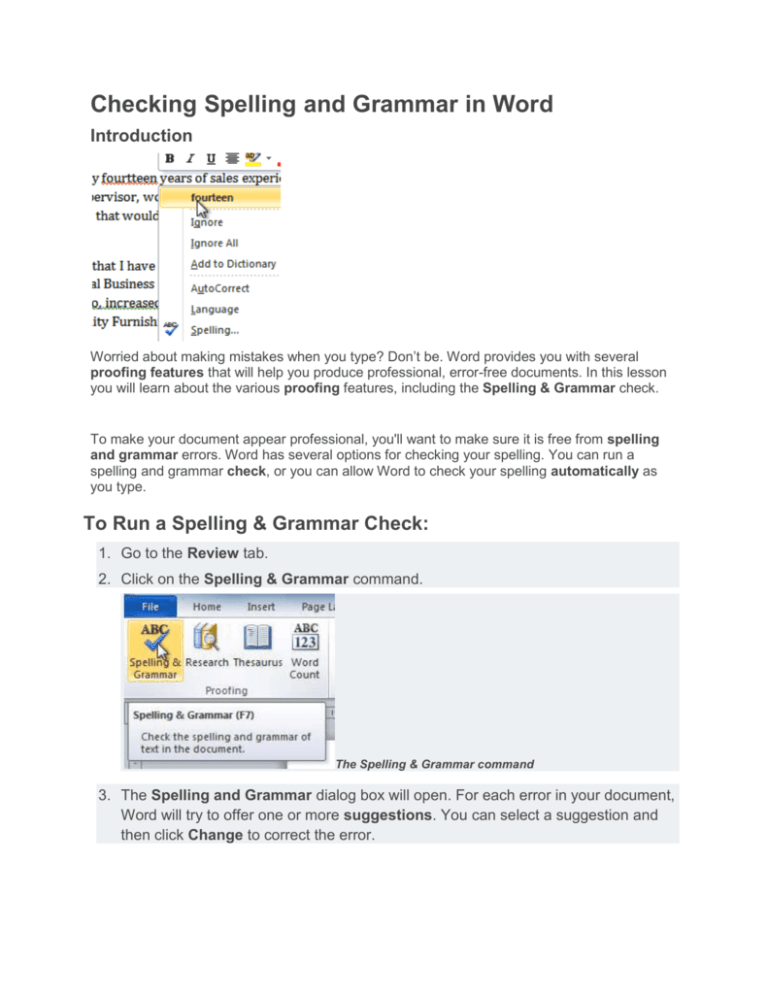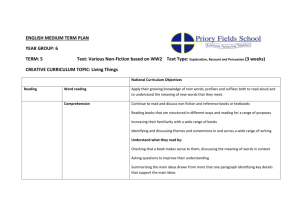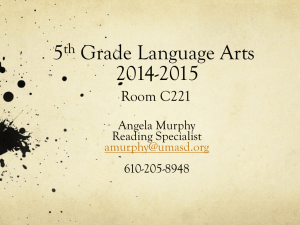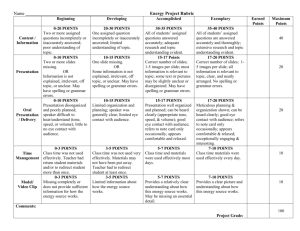Click here for the Lesson.
advertisement

Checking Spelling and Grammar in Word Introduction Worried about making mistakes when you type? Don’t be. Word provides you with several proofing features that will help you produce professional, error-free documents. In this lesson you will learn about the various proofing features, including the Spelling & Grammar check. To make your document appear professional, you'll want to make sure it is free from spelling and grammar errors. Word has several options for checking your spelling. You can run a spelling and grammar check, or you can allow Word to check your spelling automatically as you type. To Run a Spelling & Grammar Check: 1. Go to the Review tab. 2. Click on the Spelling & Grammar command. The Spelling & Grammar command 3. The Spelling and Grammar dialog box will open. For each error in your document, Word will try to offer one or more suggestions. You can select a suggestion and then click Change to correct the error. 1. If no suggestions are given, you can manually type in the correct spelling. Typing a correction Ignoring "Errors" The spelling and grammar check is not always correct. Particularly with grammar, there are many errors that Word will not notice. There are also times where the spelling and grammar check will say that something's an error when it's actually not. This often happens with people's names, which may not be in the dictionary. If Word says that something is an error, you can choose not to change it. Depending on whether it's a spelling or grammar error, you can choose from several options: For spelling "errors": Ignore Once: This will skip the word without changing it. Ignore All: This will skip the word without changing it, and it will also skip all other instances of this word in the document. Add to Dictionary: This adds the word to the dictionary so that it will never come up as an error. Make sure that the word is spelled correctly before choosing this option. For grammar "errors": Ignore Once: This will skip the "error" without changing it. Ignore Rule: This will skip this "error" as well as all other instances that relate to this grammar rule. Next Sentence: This skips the sentence without changing it, and leaves it marked as an error. That means it will still show up if you do another Spelling and Grammar check later on. If you're not sure about a grammar error, you can click Explain to see why Word thinks it's an error. This can help you determine whether you want to change it or not. Automatic Spelling and Grammar Checking By default, Word automatically checks your document for spelling and grammar errors, so you may not even need to run a separate Spelling and Grammar check. These errors are indicated by colored, wavy lines. The red line indicates a misspelled word. The green line indicates a grammar error. The blue line indicates a contextual spelling error. This feature is turned off by default. Spelling and grammar errors A contextual spelling error is when a wrong word is used, but the word is spelled correctly. For example, if I write "Deer Mr. Theodore," at the beginning of a letter, deer is a contextual spelling error because I should have used dear. Deer is spelled correctly, but it is used incorrectly in this letter. To Use the Spelling Check Feature: 1. Right-click the underlined word. A menu will appear. 2. Click on the correct spelling of the word from the listed suggestions. 3. The corrected word will appear in the document. Correcting a spelling error You can choose to Ignore an underlined word, add it to the dictionary, or go to the Spelling dialog box for more options. To Use the Grammar Check Feature: 1. Right-click the underlined word or phrase. A menu will appear. 2. Click on the correct phrase from the listed suggestions. 3. The corrected phrase will appear in the document. Correcting a grammar error You can also choose to Ignore an underlined phrase, go to the Grammar dialog box, or click About This Sentence for information about the grammar rule. To Change the Automatic Spelling and Grammar Check Settings: 1. From the Microsoft Office button, click on Word Options. 2. Select Proofing. The dialog box gives you several options to choose from: If you don't want Word to automatically check spelling, uncheck Check spelling as you type. If you don't want grammar errors to be marked, uncheck Mark grammar errors as you type. To check for contextual spelling errors, check Use contextual spelling. Changing the Proofing Options If you've turned off the automatic spelling and/or grammar checks, you can still run a check by going to the Review tab and clicking the Spelling & Grammar button. To Hide Spelling and Grammar Errors in a Document: If you're sharing a document such as a resume with someone, you might not want them to see those annoying red, green, and blue lines. Turning off the automatic spelling and grammar checks only applies to your computer, so the lines may still show up when someone else views your document. Luckily, you can hide spelling and grammar errors in a document so that the lines will not show up on any computer. 1. From the Microsoft Office button, click on Word Options. 2. Select Proofing. 3. In the drop-down box next to "Exceptions for:" select the correct document (if you have more than one document open). Creating exceptions for a document 4. Put a checkmark next to Hide spelling errors in this document only and Hide grammar errors in this document only. 5. Click OK. Challenge! 1. 2. 3. 4. Open this document. Correct the spelling errors. Correct the grammar errors. Save it in your computer folder on the Share Drive.








